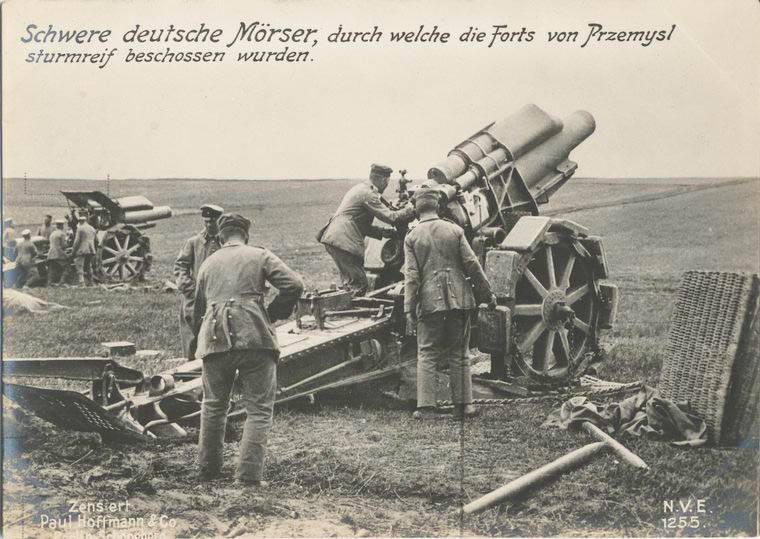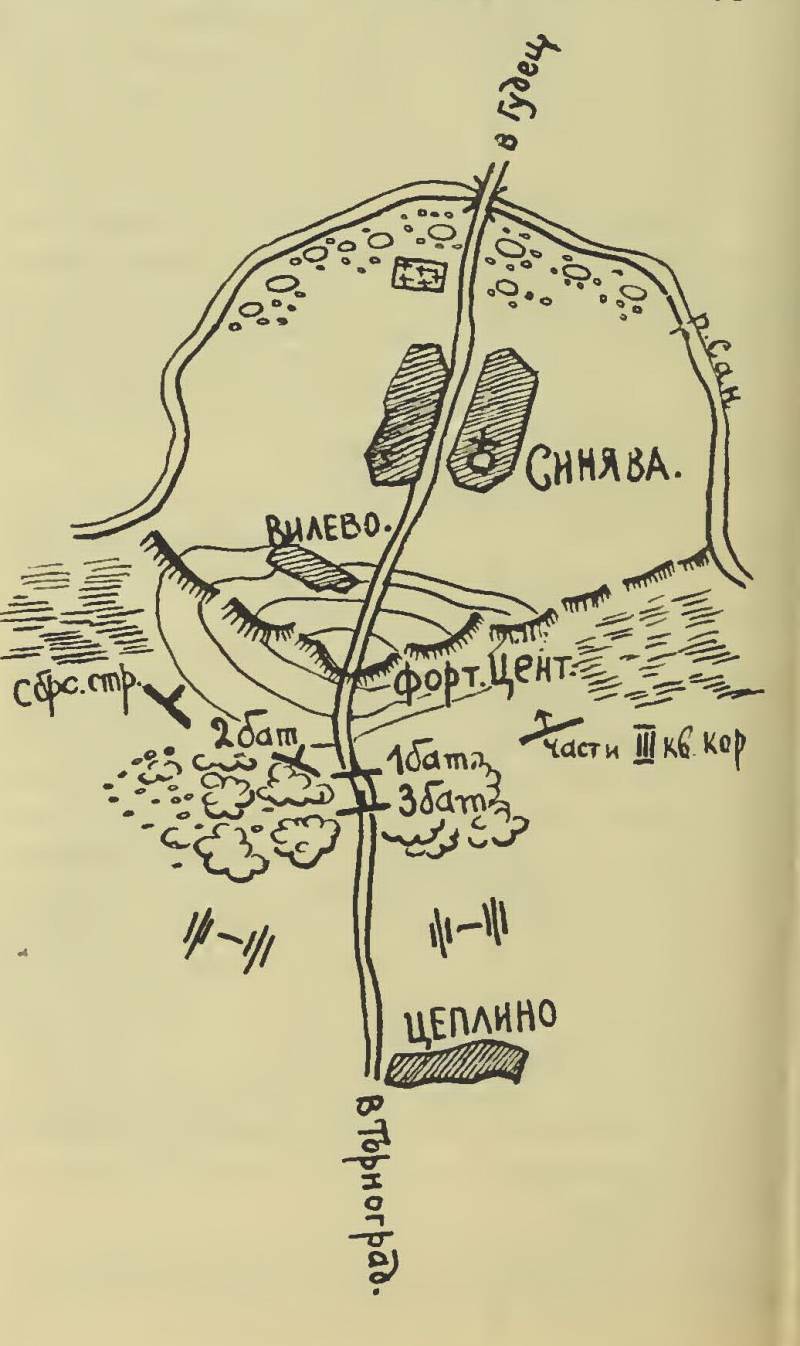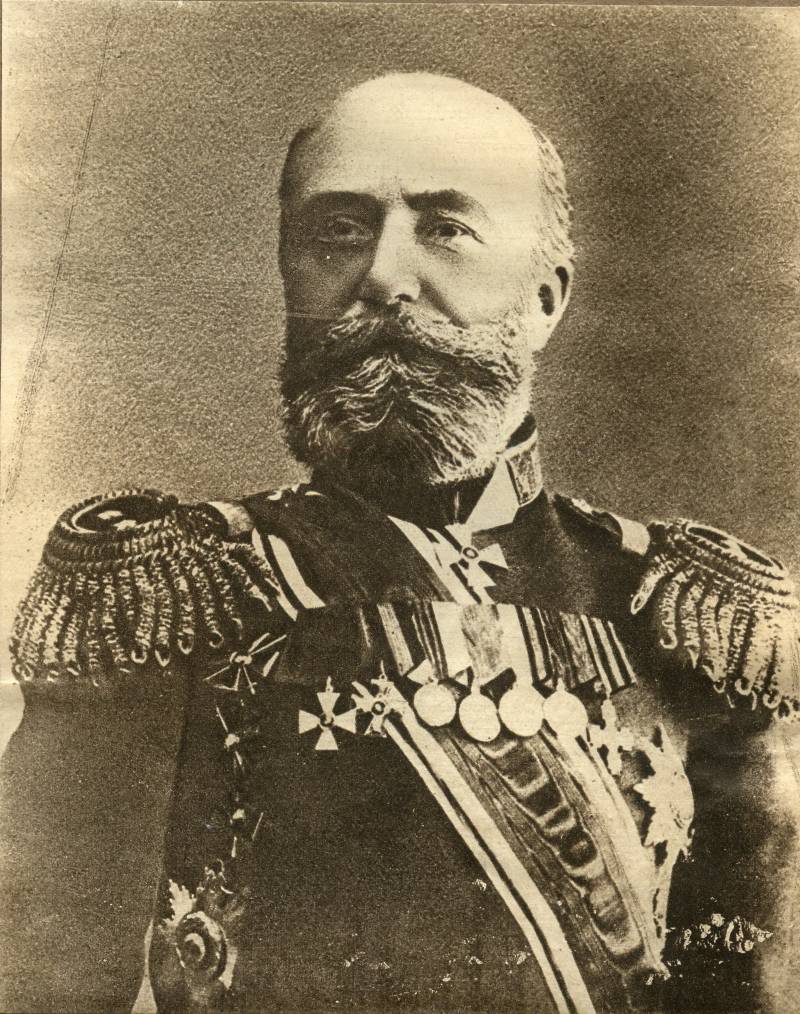Final battle for the Radymnensky key to Przemysl
Victory near Seniava
The offensive of the shock group of the 3 Army successfully developed.
By the morning of May 14, 1915, the 3 Caucasian Corps took possession of Fort Slava Gora and the trenches north of Senyava and the villages of Vilema and Gypsies. 1000 prisoners, 2 heavy guns, 4 howitzers, carts became trophies of Caucasians. 24-th corps took possession of the village. Skratka, a height south of Ignace, a forest at the height of 198, the village of Sokoly and Sedyty. 29-th Corps forced p. Lyubachevka (but later was forced to withdraw).
On the 14 of May, Russian units repulsed enemy counterattacks.
The Absheron officer recalled that the regiment should, without stopping in the trenches, continue the offensive on the village. Vilevo, pass the last and dig in the western outskirts. It began to dawn quickly, and enemy artillery fired on the trenches taken by the Russians. Arriving at the central fort, the artillery captain Kurakin began to adjust the artillery fire - and in the outskirts of the village Vilevo was covered with tears of Russian shrapnel. Russian shooters, encouraged by the success achieved and the well-aimed fire of their artillery, jumping out of the trenches, began to descend to the outskirts of the village. But they were met by strong rifle-machine gun fire, and sailed into the trenches. There were almost no casualties during the night assault, but this time many wounded remained in front of the trenches. Some of the wounded crawled or hobbled on their own, while others were carried out of the battlefield. From the village Vilevo rushed into the counterattack by the Austrians - but somehow hesitantly and languidly. The shooters, seizing the Austrian rifles lying around in many trenches in the trenches, sparing no enemy cartridges, opened strong fire on the advancing ones. Suffering heavy losses, the Austrians retreated to the village. The Russians retreated behind the retreating enemy. Artogon lit Vilevo, and the burning houses and the machine-gun along the streets prevented advancement in the village. But the attack of neighbors on the city of Senyavu, threatened to cut off the enemy from the bridges, forced him to leave Vilevo.
The Absheron people spent the night of May 15 at a position located on the western outskirts of Senyava. And the 15-th regiment knocked out the enemy from the cemetery - a stronghold that covered the crossing. After the battle, the Austrians left San, blowing up bridges - and the Absheron people occupied the assigned section of the corps position on the banks of the San.
To develop success in the offensive zone of the 3-th Caucasian Army Corps, the 31-I Infantry Division of the 10-th Army Corps was advanced. Despite significant losses in all three corps of the strike group, the Russian troops of the 3 Army achieved obvious tactical success.
The Austrian 4 Army (which numbered 113000 by the beginning of the fighting) suffered a serious defeat (in addition to the Austrian formations, the Germans also suffered significant losses - for example, the 56 I Infantry Division).
The 3-th Caucasian Army Corps defeated the Austro-Hungarian 14-th Army Corps. By the evening of May 14, 15 guns and many prisoners became trophies of Caucasians. According to a war correspondent who observed the count of prisoners, near Senyava, 7436 soldiers and officers of the enemy were captured.
At the same time, the victory at Senyava had limited, purely tactical significance. The enemy temporarily ignored the tactical defeat of one of his armies in order to achieve a more important, strategic goal. A summary of the Russian Headquarters, noting this circumstance, reported that the fighting in Galicia on the river. San continues with relentless tenacity. On the night of May 14, Russian troops launched an energetic attack on the enemy’s position north and east of Seniava and, after inflicting heavy losses on him, the next day captured the fortifications on the Pigany - Ignace front. The valiant 3th Caucasian Army Corps captured up to 6000 Austro-Germans, captured 6 heavy and 3 light guns (data by the end of the first day of the Senyavin operation - A.O.) But in the area south and east of Radymno, the enemy, who had significant superiority in artillery fire, managed to win space on both banks of the river. Sana'a.
But, at the same time, the victory had some influence on the events near Radymno. The Supreme Commander informed Emperor Nicholas II that the Senyava offensive “forced the Germans to transfer reserves north from the area of their main attack from Radymno.” In an effort to support the defeated ally, the German units began to concentrate in the valley of the river. Sklo (to the north of Zalesskaya - Volya) with the aim of attacking the 8 Army in the direction of Velky - Ochi - going into the deep rear of the right flank of this army.
L. V. (P.) On the 14 of May, Lesh ordered two cavalry divisions concentrated in the Sukha area - Volya, under the general command of the chief of the 7 Cavalry Division, Lieutenant General F. S. Rerberg to advance to Nova Grobl, Korzenitsa, Bobruvka - Trolley. The equestrian group had to solve the following problems: 1) cover the joint between the 24 and 5 Caucasian army corps; 2) a blow to the left flank of the Germans, focusing against the 8 Army in the valley of the river. Sklo, forge the active grouping of the enemy; 3), having reached the Bobruvka-Makovisko area, attack the enemy’s rear operating on the front of the 29 Army Corps and the right flank of the 8 Army. But they did not carry out the raid - the horse group was transferred to the other flank of the 3 Army.
The results of the Battle of Radymnenskaya
The battle at Radymno ended.
The battle participant formulated some tactical lessons of the operation, showing the attitude of Russian front-line soldiers to what happened. So, he noted that “we are already accustomed to a retreat” - regardless of whether the Germans defeated the Russians or, on the contrary, bristling, the Russians shattered the enemy. Everyone knew that in the end we would nevertheless retreat. It is also noted that one always has to deal with an enemy that is many times greater than the Russian number, not to mention the enormous amount of artillery of all kinds of calibers and types - which are opposed only by light 3 inch guns and a small number of field howitzers. Russians rarely see their heavy artillery. So, in the battle near Radymno one heavy division fought. Command is constantly reminiscent of the lean expenditure of shells, with the most stringent records being kept relative to the latter.
On the 15 of May, the active group of the Russian 3 Army solved offensive tasks:
The 3-th Caucasian Army Corps continued the offensive in order to establish itself on the right bank of the river. San from Piskorowice - Sieniawa - Kravchi;
The 24 Army Corps continued the operation to seize the Radava in order to establish itself at the line of Kravchi - Shmule - Radava - Skratka;
The 29th Army Corps was advancing, directing the left flank to Bobruvka - Makovisko, and its center to Katy and Olkhovo.
The enemy, however, tried not to pay attention to the tactical success of the shock group of the 3 Army. Przemysl was his goal - that is why he threw the 21 and 12 army corps of the 8 army to the right bank of the Sana'a, forcing them to withdraw to Zagrod - Kamenisko - Zalazy. The Austro-Germans wanted to achieve strategic success at Przemysl, acting from the area between the city of Yaroslav and the river. Lyubachevka. Ultimately, Radymno’s position turned out to be the key to Przemysl - the main operational goal of the enemy grouping in Galicia in May 1915. The Russian Supreme Commander informed his Sovereign that the retention of a dilapidated Przemysl in the absence of sufficient artillery and the extreme scarcity of ammunition, as well as the inability to keep it in Russian hands Yaroslav and Radymno, has become a very difficult task.

The Russian High Command, deciding to stay on the r. Sun and hold Przemysl, concentrated the 14-th army and cavalry corps at Razvadov. This group was supposed to operate behind enemy lines on the left bank of the river. San. In the area of Cieszanow - Lubaczów, the 2 Caucasian Army Corps was nominated as a general reserve of the front.
The concept of "retaining the conquered space" continued to be implemented at the expense of the maneuverability of the armies of the Southwestern Front. The enemy continued to “peck” at the joints between the Russian armies and to the most vulnerable places of their defense, precisely counting on the immobility of the operational associations of the South-Western Front. The 3-I and 8-I armies absorbed a significant part of the corps being transferred to the South-Western Front - without achieving a meaningful operational-strategic result.
An attempt to achieve such a result was paralyzed both by the lack of full reserves, and by the weak combat strength of the Russian formations. A vivid illustration is the episode of the operation under consideration. So, taking into account that the enemy left the right bank of the San north of the mouth of the river. Lyubachevka (on the combat site of the 3-th Caucasian Corps), and in front of the left flank of the 24-th and the front of the 29-th Army Corps, is stubbornly resisting, the commander of the Russian 3-th Army ordered the capture of Radava. This would make it possible to go to the flank and rear of the German fortified position in the region of Tsetula (i.e., the main German position on the front of the Russian 3 Army). Transfer of part of the forces of the 3-th Caucasian Corps to the left bank of the river. Sun and the capture of the crossing at Lezakhov made it possible to attack the enemy in the rear. In fact, it was an attempt to strike at the flank and deep rear of the enemy strike group (2 corps), which was concentrated between the San River and the river. Lyubachevka for attack Przemysl from the north. The operational plan is absolutely correct, but impossible due to the above reasons. If a powerful strike group had been concentrated in the region of the 3 Caucasus, the fate of Peremyshl could have been different, and the enemy, preparing a deep bypass of the right flank of the 8 Army and the fortress, would not have decided on such a maneuver. The Austro-Germans were well aware that they could neglect the threat from the 3 Army, bloodless in previous battles.
Sources of
RGVIA. F. 2007. Op.1. D. 42. H. 1;
Collection of documents. Gorlitsky operation. M., 1941;
Year of war from 19 July 1914 g. To 19 July 1915 g. M., 1915;
Chronicle of the war. 1915. 40 number;
Reichsarchiv. Der Weltkrieg 1914 - 1918. Bd 7. Berlin, 1931;
Reichsarchiv. Der Weltkrieg 1914 - 1918. Bd 8. Berlin, 1932;
Österreich-Ungarns Letzter Krieg 1914 -1918. Bd ii. Wien, 1931;
D-sky M. How the count of prisoners is made // Niva. - 1915. - No. 46;
Wevern B.V. 6 Battery. 1914 - 1917 The story of the time of the great service to the Motherland. T. 2. Paris, 1938;
Colonel Ryabinsky. Night attacks. From the recollections of the first Great War 81 of the infantry Absheron Empress Catherine the Great Regiment // Military Story. 1962. 53 number;
Brusilov A. A. My memories. M., 1983;
Ludendorff E. background. My memories of the war 1914 - 1918 years. M. - Mn., 2005;
Washburn S. The Russian campaign. April to august 1915. London, 1915.
Literature
The composition of the German army according to the 1 in May 1915 Warsaw, 1915;
The combat schedule of the Austro-Hungarian army. B. m., 1915;
Great War. 1915 year. Russian Western Front. Pg., 1916;
Strategic essay on the 1914 war - 1918's. CH 4. M., 1922;
Ritter H. Criticism of World War. Pg., 1923;
Yu. N. Danilov. Russia in World War 1914 - 1915 Berlin, 1924;
Bonch-Bruevich, M.D., Our loss of Galicia in 1915, Part II. M. - L., 1926;
Rubets I.F. Equestrian attacks of the Russian Imperial Cavalry in the First World War // Military Story. 1965. 76 number;
Kersnovsky A. A. History Russian Army. TT. 3 - 4. M., 1994;
Participate in the War (1914-1918). Washington, 1920.
- Oleynikov Alexey
- Senyava 1915. Perfect night attack
Bloody Radymno. Gunners, cavalry and plastuy on the path of the "rink" A. Mackensen
Battle of Radymno. First round
Final of the Battle of Yaroslav. Will we hold on to Sana'a?
The struggle for the initiative in the battle of Yaroslav. Two counterattacks
The apogee of the 1915 battle of the year near Yaroslav. Canceled order of Radko-Dmitriev
Heavy May Day under Yaroslav
Battle of Yaroslav. Key position of the Third Army
Battle of a Polish city with a Russian name. CH 1. Bridgehead at Yaroslav
The 3 Caucasian Corps is on the path of a strategic hurricane. Part of 4. Calculations and prospects
The 3 Caucasian Corps is on the path of a strategic hurricane. Part of 3. Day of disaster
The 3 Caucasian Corps is on the path of a strategic hurricane. Part of 2. The backbone of the army group
The 3 Caucasian Corps is on the path of a strategic hurricane. Part of 1. Elite entered into battle
Under the blow "ram" Mackensen


Information